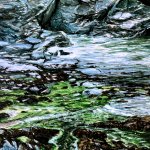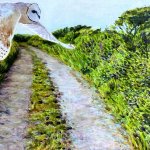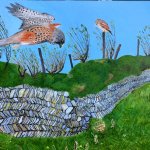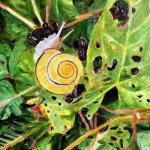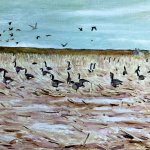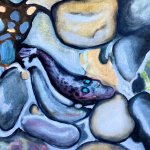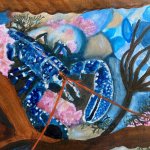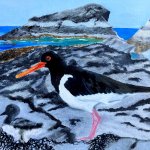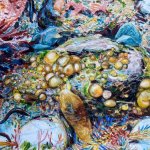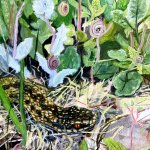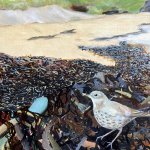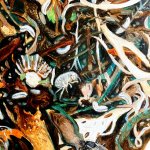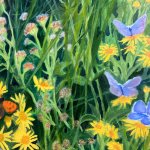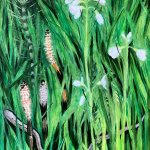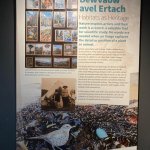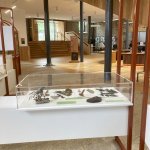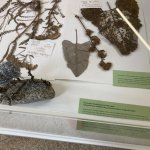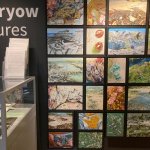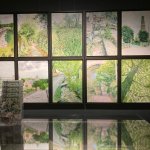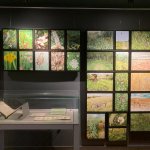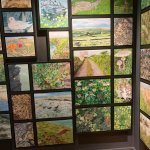Habitat Project 2022 with Kresen Kernow
Biodiversity, in the ecosystems of the world, is declining and needs protection. To protect plants, insects, birds and animals we need to know about the natural habitats and ecosystems in which they live but we don’t need to go to them. When we visit wild places we can be the cause depletion and disturbance. We need to protect wild places because they are part of our natural ecosystem, which is essential for our survival. Recording wildlife in surveys is important for research and conservation. Drawing and painting, making notes and photography and film have all contributed to the conservation of particular species. Painting entire habitats can record a place in time. All habitats are under pressure because of human induced climate change and there is value in recording the habitats now for the future. Observational recording also increases our understanding of each species.
The Habitats Project includes an Exhibition, Workshops, Residency and Book
Funded by Arts Council and Kresen Kernow
This project was inspired by the work of Marianne North at Kew Gardens

Exhibition at Kresen Kernow
This project represented nine different natural habitats of St Eval and Redruth in paint. A total of a hundred small paintings show the diversity of natural life, in these areas of Cornwall, and how they are interconnected. St Eval is a rural parish on slate rock with a long stretch of coastal cliff and beaches, about seven square miles in area. Redruth is a historic post industrial town on granite.
Paintings were exhibited in the Treasury Gallery at Kresen Kernow June to the end of August 2022
Redruth Bell Tent Workshops/ Surveys
In May/June 2022 Tebbs and Darke will made surveys, with participants of Redruth, from a bell tent, dressed as Victorian plant hunters. The surveys were set in different areas of Redruth:
- Redruth School grounds
- St Euny Churchyard
- Kresen Kernow grounds
- Illogan Churchyard – with Shallal
Participants recorded the plants, insects and animals present in a variety of ways, exploring the value of observational drawing and writing.
Residency at Kresen Kernow
During August 2022 Darke and Tebbs will run workshops and show films, inviting conservationists, naturalists and artists to the educational room at Kresen Kernow, including Cornwall Wildlife Trust.
Dates of daily events announced on Kresen Kernow site in June/July 2022
Habitats as Heritage at Kresen Kernow – August residency events
Artists Jane Darke and Andrew Tebbs ran a series of workshops, film showings and activities at Kresen Kernow to complement their Habitats as Heritage exhibition, which features 100 paintings of local habitats in the summer of 2022.
See the residency event list here (downloadable document) or view the full list below:
– Drop-in sessions looking at plants through a microscope and drawing what you see, led by Darke and Tebbs (materials provided).
– Colin French gave a talk about his book Flora of Cornwall. Colin also discussed the plants of Hayle and Godrevy Towans, and those on granite around Redruth, including the impact of mining which has significantly shaped the flora of this area.
– Red River: Listening to a Polluted River– poet John Wedgewood Clarke who introduced the Red River project and shared some of the research that went into the making of his long poem Red River: A River in Pieces. The session will included discussion and an opportunity to write about the Red River and our attitude towards rivers. It will end with a short reading from Red River.
Dr John Wedgwood Clarke is senior lecturer in Creative Writing at the University of Exeter and director of the AHRC-funded project Red River: Listening to a Polluted River. He also researched and presented the BBC4 documentary Cornwall’s Red River.
– Darke and Tebbs ran a viewing of their documentary, shown on BBC FOUR, The Poet Charles Causley (60 minutes) with readings of Causley’s poems about nature.
– Made photos using plant juices! This Anthotype workshop took place across two weeks and was led by artist Rachael Jones. Participants experimented to see which plants, found in the grounds of Kresen Kernow, produce the best photographs. Materials provided.
– Director Jane Darke ran a viewing of her documentary film The Wrecking Season (60 minutes) participants explored her collection of natural objects found on beaches around the world.
– A selection of showings of 1960s 8mm film of wildlife in St Eval made by ornithologist and farmer Bob Darke (father of writer, Nick). Subjects include The Food Chain, Pond Life, Cornish Seabirds, Sand Dunes and My Cornwall.
– Made photos using plant juices! This Anthotype workshop took place across two weeks and was led by artist Rachael Jones. Participants experiment to see which plants, found in the grounds of Kresen Kernow, produce the best photographs. Materials provided. Booking advisable.
– Shoreline secrets. Matt Slater, Marine Conservation Officer at Cornwall Wildlife Trust, hosted a talk on his favourite marine creatures and surprising stories about their biology and behaviour. This harsh environment has changed dramatically in the past 20 years and Matt discussed these changes and how you can get involved in monitoring and protecting our marine wildlife.
– Biologist Dr Richard Pearce conducted a talk about his study of limpet recovery since the Torrey Canyon oil spill fifty years ago. His study also shows species variation due to climate change.
– Polly Roberts, poet and nature writer, hosted a reading from her poetry collection Grieving with the Animals and her novel Together We Evolve, discussing themes of rewilding, nature as therapy and the climate crisis. There with time questions and open discussion as well as a short creative writing exercise.
– Walk around Redruth identifying trees and drawing them from life led by Darke and Tebbs. Participants met at Kresen Kernow.
– Conserving Cornwall’s Cetaceans. Cornwall Wildlife Trust hosted a talk about their work protecting our iconic dolphins, porpoises and whales.
– Darke and Tebbs host a seaweed sensation! Teaching participants how to identify different species, look at pressed specimens and understand how to preserve them.
Habitats Book – Habitats of St Eval


